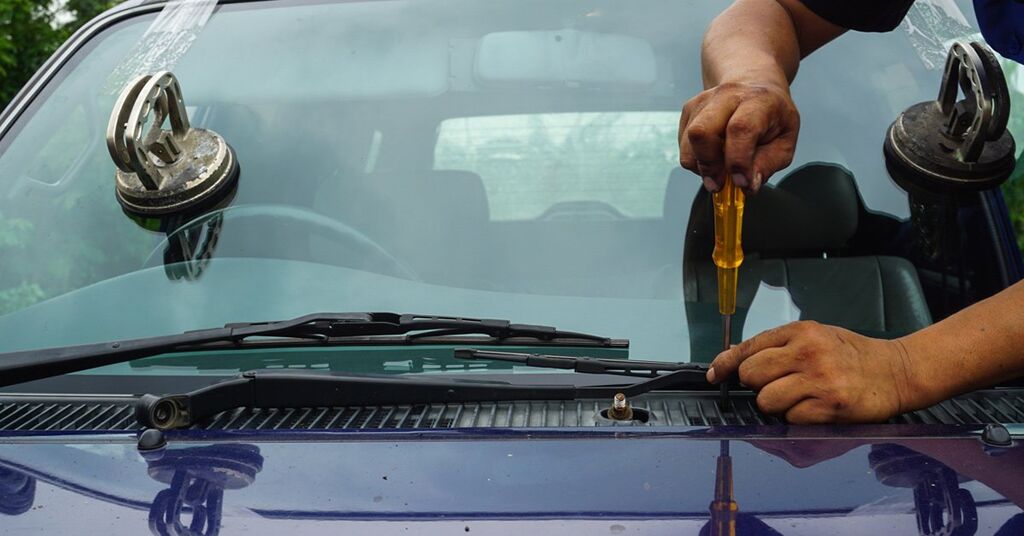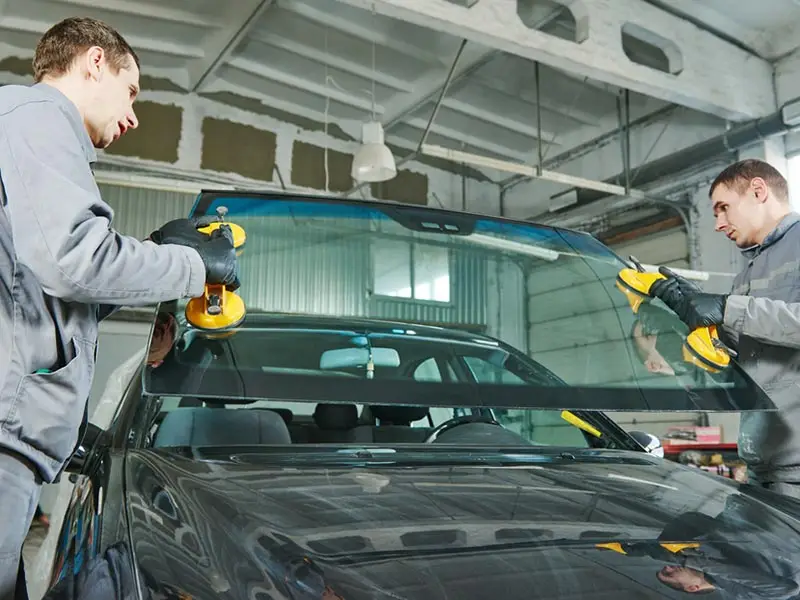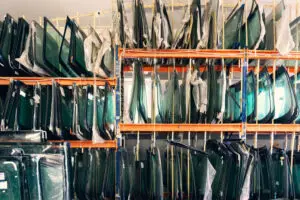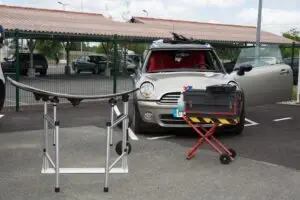Windshield replacement and repair are services focused on addressing damage to the windshield of a vehicle.
Windshield Replacement: Windshield replacement involves removing the damaged or broken windshield and installing a new one. This service is typically necessary for severe damage that cannot be repaired or if the windshield is compromised to the extent that it affects the safety of the vehicle. During a replacement, the old windshield is carefully removed, the frame is cleaned and prepared, and a new windshield is installed using adhesive materials to ensure a secure and proper fit.
Windshield Repair: Windshield repair is a process of fixing minor damage, such as small chips or cracks, on the windshield. Repairing the windshield is a cost-effective solution that helps prevent further damage and restores the structural integrity of the glass. The repair process usually involves injecting a special resin into the damaged area, which bonds with the glass and restores its strength and clarity. The repaired windshield should maintain its integrity and visibility, providing a durable fix for minor damage.
Both windshield replacement and repair services are essential for maintaining the safety and functionality of a vehicle’s windshield. The appropriate service depends on the severity and nature of the damage, and a professional auto glass technician can assess the situation and recommend the most suitable solution.

repair windshield
Windshield repair is typically recommended for minor damage such as small chips or cracks. Here are some situations when windshield repair is often appropriate:
- Small Chips: If your windshield has small chips caused by rocks, debris, or other objects, and the size of the chip is smaller than a quarter (around 1 inch or 25 mm) in diameter, it is usually repairable.
- Cracks: Certain types of cracks, such as short cracks (typically less than 6 inches or 15 cm) and surface-level cracks that have not penetrated through the entire thickness of the glass, can often be repaired.
- Immediate Action: It’s best to address the damage promptly. If you notice a chip or crack in your windshield, getting it repaired as soon as possible can prevent it from spreading or becoming more extensive.
- Location of Damage: The location of the damage plays a role in determining repairability. If the chip or crack is not in the driver’s line of sight and is away from the edges of the windshield, repair is more likely to be a viable option.
It’s important to note that the above guidelines are general, and the final decision on whether to repair or replace the windshield should be made by a professional auto glass technician. They will assess the specific damage, consider its size, location, and type, and provide you with a recommendation based on their expertise.
Windshield replacement
Windshield replacement is typically necessary in the following situations:
- Extensive Damage: If the windshield has severe damage, such as large cracks that extend across the windshield, multiple cracks, or significant damage in the driver’s line of sight, replacement is often the recommended solution.
- Structural Integrity Compromised: When the structural integrity of the windshield is compromised, it is crucial to replace it. This includes situations where the damage is extensive, affecting the strength and stability of the glass.
- Damage in Critical Areas: If the damage is located near the edges of the windshield, it can weaken the glass and potentially lead to further cracking or detachment. In such cases, replacement is usually necessary to ensure the windshield’s stability.
- Previous Failed Repairs: If attempts have been made to repair the windshield but the damage persists or the repair has not been successful in restoring the integrity of the glass, replacement may be the appropriate course of action.
- Safety Concerns: Ultimately, the decision to replace the windshield is influenced by safety considerations. If the damage poses a safety risk for the driver and passengers, replacement is often recommended to ensure optimal protection.
It is essential to consult with a professional auto glass technician who can assess the specific damage and provide a professional recommendation based on their expertise. They will consider factors such as the size, type, and location of the damage to determine whether repair or replacement is the most suitable option.
Is Windshield repair safe?
Yes, windshield repair is generally considered safe when performed by a professional technician using the appropriate techniques and materials. Here are a few points to consider regarding the safety of windshield repair:
- Structural Integrity: Windshield repair is designed to restore the structural integrity of the glass. By injecting a specialized resin into the damaged area, the repair process strengthens the glass and prevents further spreading of the damage.
- Approved Techniques: Professional auto glass technicians follow approved repair techniques that adhere to industry standards. They are trained to assess the damage and determine if it is suitable for repair. Properly executed repairs ensure the windshield retains its strength and does not compromise safety.
- Visibility and Clarity: A high-quality windshield repair should result in minimal visibility distortion or impact on the driver’s line of sight. The resin used in the repair process is optically clear and aims to restore the transparency of the glass, improving visibility.
- Expertise and Experience: Choosing a reputable auto glass repair provider ensures that experienced technicians handle the repair. Their knowledge and expertise in identifying repairable damage and executing the repair process correctly contribute to the safety and effectiveness of the repair.
It’s important to note that the suitability of repair depends on the specific characteristics of the damage, such as its size, location, and type. A professional technician can assess these factors and provide guidance on whether repair is a safe and viable option for your windshield.
windshield repair kits
Windshield repair kits are tools designed to facilitate DIY repairs for minor chips and cracks in windshields. These kits typically include the necessary materials and instructions to carry out the repair process. Here are a few key points to know about windshield repair kits:
- Contents: Most windshield repair kits include a specialized resin, a syringe or applicator device, curing film or strips, and any additional tools required for the repair. The resin is the key component used to fill the damaged area and restore the integrity of the glass.
- DIY Repair: Windshield repair kits are intended for DIY use, allowing vehicle owners to attempt repairing minor damage on their own. They provide a cost-effective alternative to professional repairs, particularly for small chips or cracks.
- Limitations: It’s important to note that windshield repair kits have limitations. They are typically designed for small, non-extensive damage such as chips and cracks under a certain size. Larger or more severe damage may require professional attention or windshield replacement.
- Skill and Technique: Achieving a successful repair with a windshield repair kit requires some skill and technique. Following the instructions carefully, practicing proper resin application, and understanding the limitations of the kit are important for obtaining satisfactory results.
- Effectiveness and Safety: The effectiveness and safety of repairs using windshield repair kits can vary. While many kits can provide satisfactory results for minor damage, it’s crucial to remember that professional repairs offer more advanced tools, resins, and expertise to ensure the best outcome.
If you decide to use a windshield repair kit, carefully read and follow the instructions provided. However, for larger or more complex damage, or if you are unsure about performing the repair yourself, it is recommended to consult a professional auto glass technician who can assess the damage and recommend the appropriate course of action.

what do you know about windshield glass?
Windshield glass, also known as laminated glass, is a specialized type of glass used for automotive windshields. Here are some key points about windshield glass:
- Safety and Durability: Windshield glass is designed to be strong and durable to withstand the rigors of the road. It is made up of two layers of glass with a thin layer of vinyl or polyvinyl butyral (PVB) interlayer sandwiched in between. This construction provides enhanced safety as the interlayer holds the glass together in the event of a break, preventing it from shattering into sharp pieces.
- Impact Resistance: Windshield glass is engineered to have good impact resistance, making it more resistant to chips, cracks, and damage caused by road debris, stones, or minor collisions. The laminated construction helps to distribute and absorb impact forces, reducing the likelihood of glass breakage.
- UV Protection: Windshield glass is often equipped with built-in UV protection. The PVB interlayer helps to block a significant amount of harmful ultraviolet (UV) rays, reducing the risk of sun damage to the vehicle’s interior and providing some level of protection for occupants.
- Optical Clarity: Windshield glass is designed to offer excellent optical clarity, ensuring clear visibility for the driver. The glass undergoes various manufacturing processes to minimize distortions and maintain high transparency, contributing to safe driving conditions.
- Integrated Features: Modern windshield glass may also incorporate additional features and technologies. This can include embedded sensors for rain detection, heads-up display systems, or advanced driver assistance system (ADAS) components, enhancing the functionality and safety of the vehicle.
Windshield glass plays a crucial role in protecting the occupants of a vehicle and maintaining clear visibility. Its specialized construction and properties make it a critical component of automotive safety and comfort.
windscreen or windshield
The terms “windscreen” and “windshield” are often used interchangeably and refer to the same component of a vehicle. Here’s some information about windscreen or windshield:
- Purpose: The windscreen or windshield is the front window of a vehicle that provides a barrier between the occupants and the external environment. It serves multiple purposes, including protecting occupants from wind, debris, and weather elements while allowing clear visibility for the driver.
- Safety and Structural Integrity: The windscreen is an integral part of a vehicle’s structural integrity, contributing to the overall strength of the vehicle’s body. It helps to maintain the structural integrity of the cabin during accidents or rollovers by preventing the roof from collapsing.
- Materials: Most modern windshields are made of laminated glass, which consists of two layers of glass with a layer of polyvinyl butyral (PVB) interlayer sandwiched in between. This construction enhances safety by preventing the glass from shattering into sharp pieces upon impact.
- Impact Resistance: Windshields are designed to be impact-resistant, providing protection against stones, road debris, and minor collisions. The laminated glass construction helps to distribute and absorb the forces from impacts, minimizing the risk of glass breakage.
- Visibility and Optical Clarity: Windshields are engineered to offer excellent optical clarity to ensure clear visibility for the driver. Advanced manufacturing processes are employed to minimize distortions and maintain high transparency, allowing the driver to have a clear view of the road.
- Advanced Features: Modern windshields may incorporate additional features and technologies. These can include embedded sensors for rain detection, temperature control, heads-up display systems, or various advanced driver assistance system (ADAS) components.
Overall, the windscreen or windshield is a crucial component of a vehicle, providing protection, structural support, and clear visibility. Its design and construction contribute to the safety and comfort of the occupants, making it an essential part of automotive engineering.
windshields required exception must be unobstructed
Windshields are indeed required to be unobstructed in order to ensure the safety of the driver and passengers. Here’s some information about the requirement for unobstructed windshields:
- Clear Visibility: Windshields must provide a clear and unobstructed view of the road ahead for the driver. This is crucial for safe driving, as it allows the driver to see potential hazards, pedestrians, other vehicles, and road signs.
- Legal Requirement: In most jurisdictions, it is a legal requirement for windshields to be free from obstructions. Any objects, stickers, or materials that significantly obstruct the driver’s field of vision are generally not permitted.
- Regulations and Standards: Governments and transportation authorities establish regulations and standards regarding windshield visibility. These regulations often specify the maximum allowable obstruction, such as the size and placement of stickers or objects on the windshield.
- Safety Considerations: Obstructed windshields can significantly impair the driver’s ability to react to changing road conditions and hazards. Objects or obstructions on the windshield can create blind spots and reduce visibility, increasing the risk of accidents.
It is important for drivers to ensure that their windshields are free from obstructions and adhere to the legal requirements in their jurisdiction. Any objects or materials that obstruct the driver’s view should be removed or repositioned to ensure clear visibility and safe driving.




